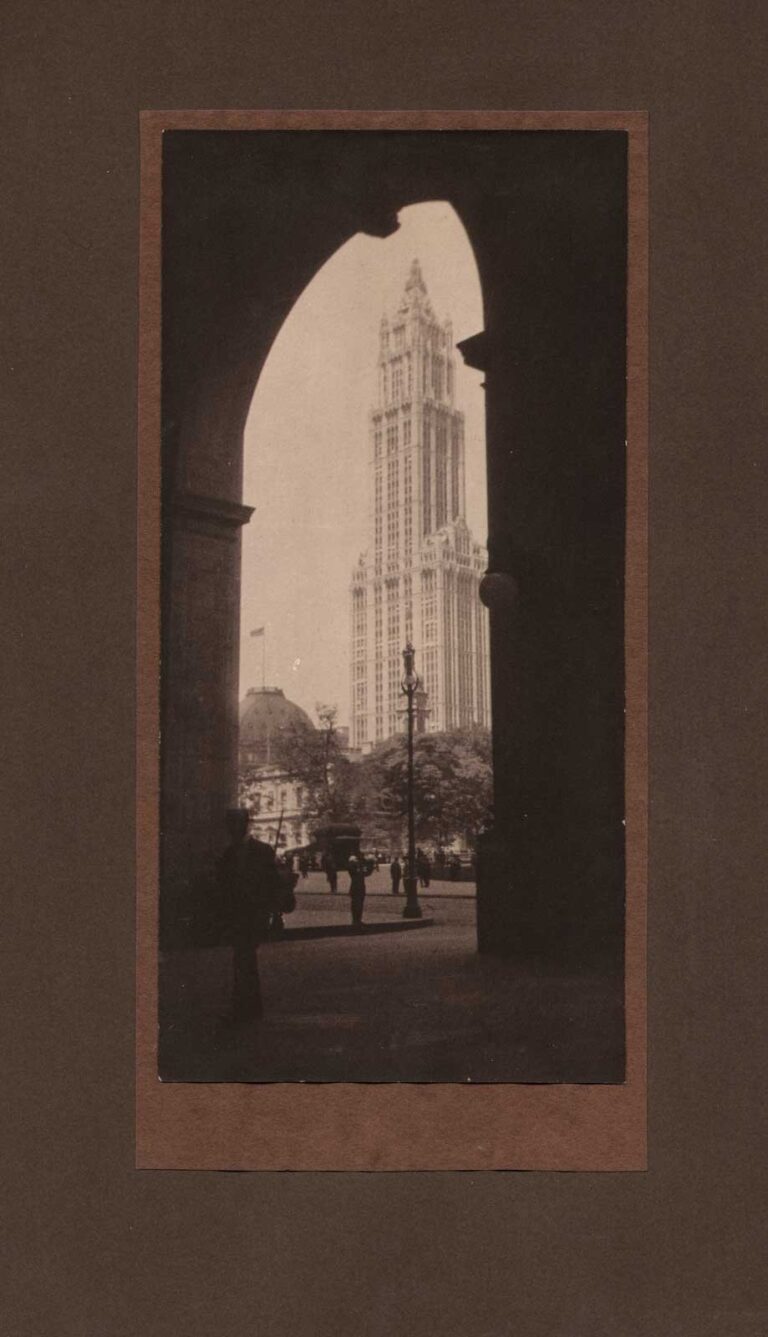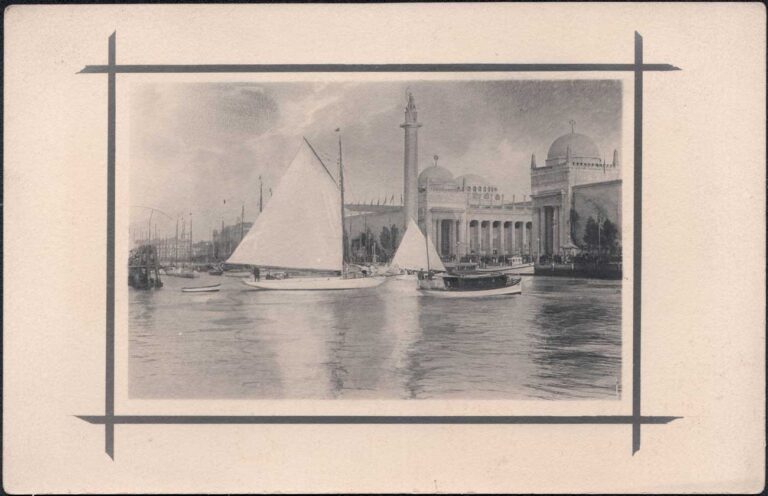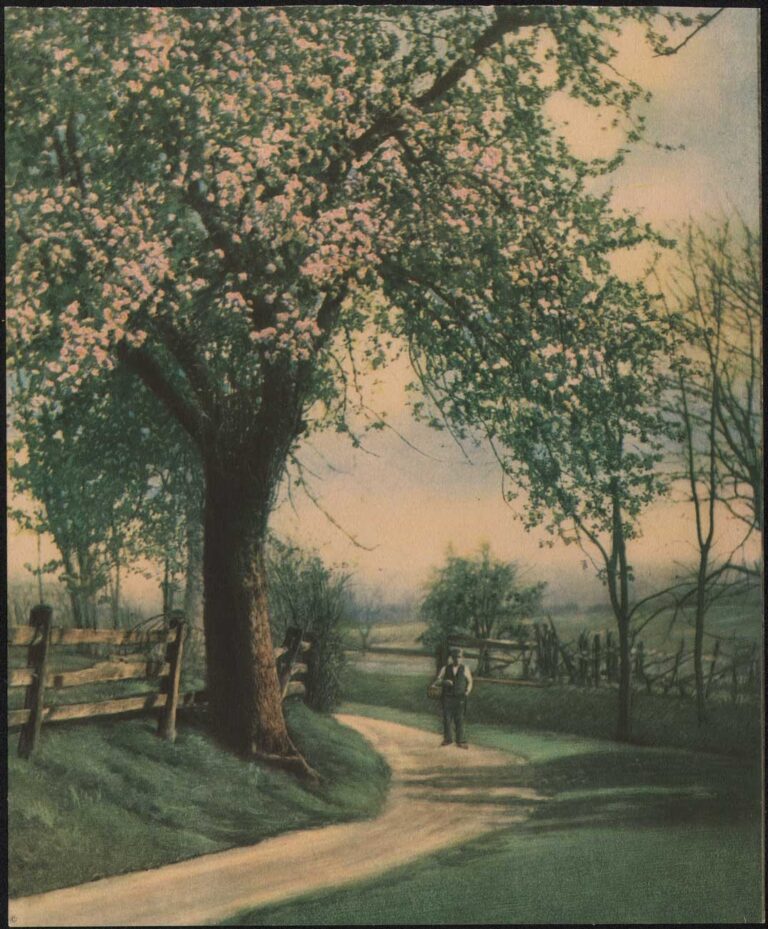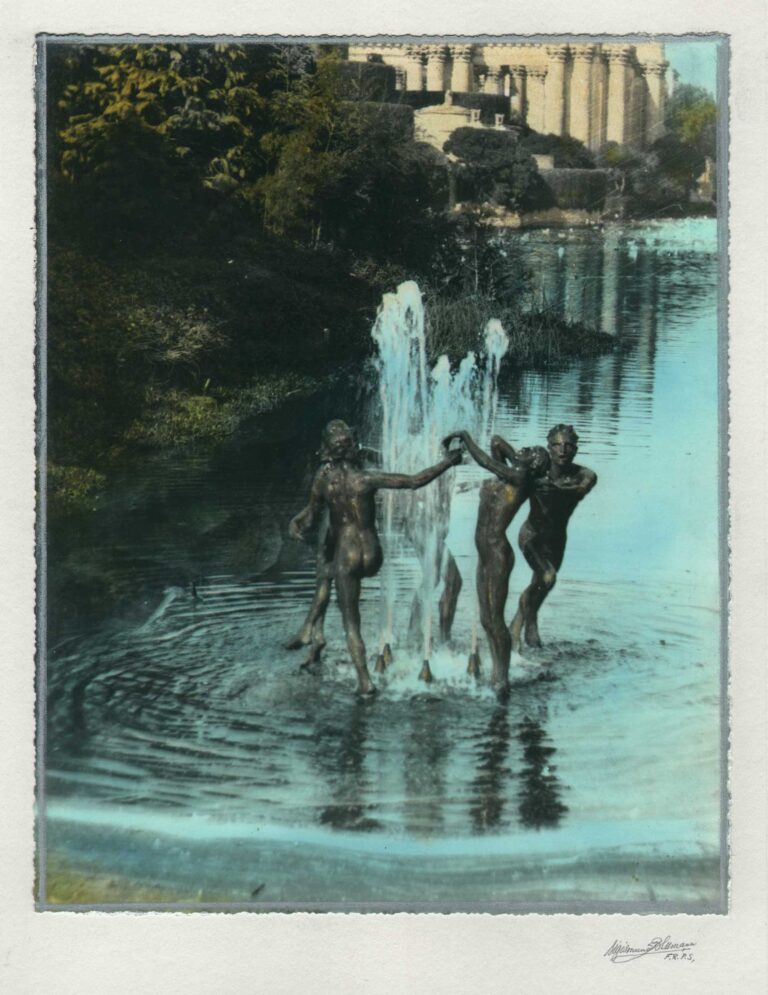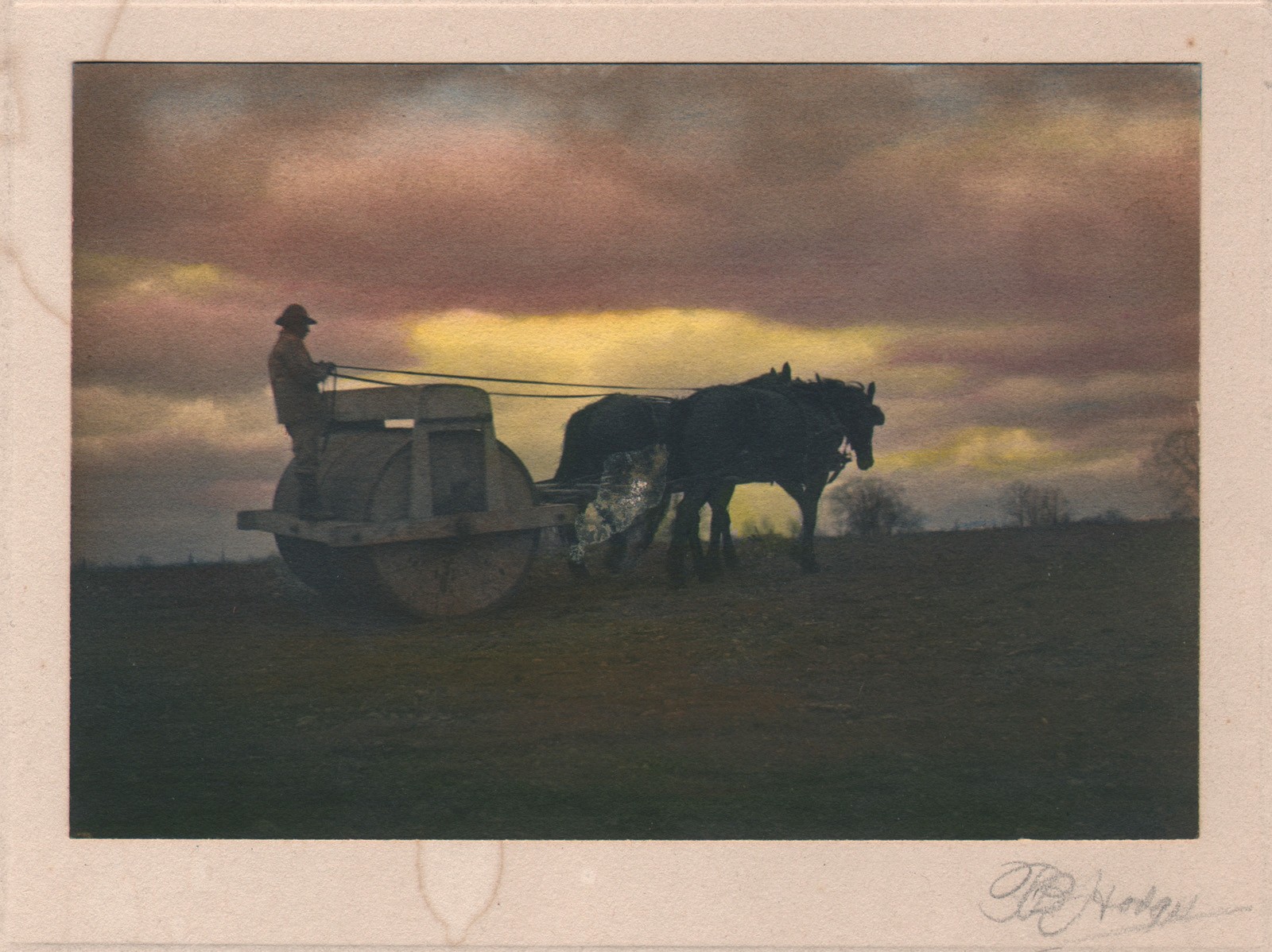
November Skies
The following remembrance of the month of November, accompanied by a reproduction of his photograph November Skies, appeared in the journal The Camera for the month of November, 1915. (The Camera Publishing Company: pp. 641-42) This work also known as The Old Farm Roller, as published in Photo-Era for June, 1922.
NOVEMBER
FRED’K BRITTON HODGES
NOVEMBER, the dreary month, the month of gray days, incipient snows and days of wind and storm. The winds of November are charged with a portending chill, and fill the air with tidings of the frozen season so near at hand.
One of the old Anglo-Saxon names for this month was “Windmonath” (Windmonth), so it would seem that November was ever possessed of the same traits of character that she displays now.
To the man who loves the woods and the open places of Nature, and has always roamed their spaces with his dog and gun, this dreariness, this dull, faded aspect of the land, is fascinating. The all-pervading gloom becomes to him a restful quiet—the storm winds sing, through his being, a soothing melody. The rain, beating in his face, fills him with a strange sense of freedom. He is alone with the elements; and the face of Nature, always beautiful to him, is forcing upon him a stronger meaning than at the other seasons. Underneath the surface sensations, there runs a coursing stream of full, deep significance, convincing and dependable.
These things I know, because for years the November’s have yielded me rich harvests of poetic delight. Each November, to me, is full of individuality; and, unlike the other months, which merge into each other more or less, this month of saddened glories leaves its own distinct impression.
I never think of Autumn as the death of the year; but, as I live through the changing days, it seems to me only a transition of Nature. There is no death or age in the beautiful places of Nature, for always, at the heart of things, is life and youth.
If you own a camera — never mind its size or cost — you can experience, in November, the same delightful charm that fascinates the hunter. Indeed, I think—and I have been both—that the man with a camera finds an additional quota of November’s bewitchment, visible and invisible.
November offers pictorial attractions for all tastes. The worker who likes clear, sharp, plucky negatives, to the exclusion of all others, can find plenty of material that should be photographed in just his way. The interpreter of impressions, seeking to represent, in as high a degree as possible, the mysterious and indefinable melancholy that so many November days are imbued with, can find, in no other month, such days of poetic perfection — temptations that will tax his ability and dexterity to the utmost.
His efforts to picture the month’s character, however, when successful, will be the most satisfying of the year. Through the mornings, days and evenings of this month, the landscape is impregnated with a rare peace and a touching benignity, so beautifully, perfectly and entirely harmonious, as to be never monotonous.
The work, perhaps more especially the motives, of the rank and file of photographers, shows a striking lack of those ideas that result from refined and studious thought.
Journeys into Nature’s picturesqueness, in November, will prove, to them, inspirations of lasting worth, for, as we roam in her quiet retreats, in this month of serious beauty, so softly radiating through the grayness, we inevitably yield to its seductive influence, and the desire for more cultured thoughts is certain.
At the same time, no matter how much you visit Nature’s great outdoors, these lessons will have no intrinsic value for you, unless you pursue a fixed method of careful, deliberate and loving study. There is so much at our disposal in the richness of Nature that we can have almost any conception, and her varied possibilities will fit it. Therefore, it is a mistake to travel constantly to new places, thinking to find landscapes of more appealing beauty; rather, by daily visits to the home scenes, become so much a part of them that their interpretation becomes possible to you. The quality of our first impressions is not often of the high standard that constant study brings. The first glimpses of the landscape are the more superficial, and the resulting pictures usually express nothing of the clearer insight that dominates our later vision.
The years’ end in November, after all the glorious riot of summer verdure, brings opportunities to observe how full of inspiring force are the more subtle phases of Nature. We are shown to what an extent we are charmed by the variety of form.
Let us call November the broadening month, the month in which we cast out the selfish intrusions that will creep in and occupy some of the valuable space in our minds, and look with clear, sane eyes. Our ideas are not large enough—no, it is hard to make them so. It takes us a long time to discover good in the work of others, that we disdained, at first, to give a second glance.
Timeline: Frederick Britton Hodges: 1868-1955
Hodges work is still being discussed in the 21st Century. In 2015, an article by Rome (New York) Historical Society Museum Educator Caitlin Matwijec on the photographer in relation to the town’s natural history appeared in the Rome (N.Y.) Sentinel newspaper, with the artist described as a “prolific Roman photographer, journalist, poet, and naturalist”.
1868: Born in Rome, New York on September 13.
1886: Acquires his first camera, the same year he marries first wife Esther M. Hall of Taberg, N.Y.
1900: U.S. Census listed his occupation as florist.
1908: Mention of the artist’s photographs, (most likely hand-colored) perhaps the first where he marketed his work, appears in the August 20th issue of Geyer’s Stationer (A weekly devoted to the interests of stationery and kindred trades) as part of an article on a Print Publishers exhibition “now in progress at the Park Avenue Hotel” in N.Y.C.:
Conspicuous in the Woodbury E. Hunt Co. display, in charge of William E. Hough, is the original of their splendid calendar subject, “When the Heart Calls,” by Warren B. Davis, a number that has been extensively bought. While the Hunt display is along the line shown at the Philadelphia exhibition in May last, and described at length in our issue of May 21, a new line of nature studies by F. B. Hodges is shown, a clever artist who is rapidly forging to the front. A platinum showing “Saranac Lake” is fine, as are two numbers by Arthur I. Keller, “The Wooing of Anne Hathaway” and “The Garden of Anne Hathaway,” both painted from actual photographs. (p. 8)
1937: Excerpt: “Colored scenics, beautifully blended, constituted the entries of Frederick B. Hodges.” Source: CAMERA ART SHOW PROVES POPULAR : in: DAILY SENTINEL, ROME, N. Y., FRIDAY EVENING, FEBRUARY 26, 1937.
1945: Article: “HODGES EXHIBITS PICTURES AT CLUB”
A gum print exhibition featuring photographic studies of the Rome countryside, made and colored by Frederick B. Hodges, well known Rome artist and nature writer, is being held during the month of April at the Woman’s Club. It is sponsored by the fine arts department of which Miss Miriam Gladding is chairman. Thirty prints picturing scenes of the canal, the river, pastures and woods about Rome are included in the exhibition. The gum print process, which allows great latitude for the artist’s expression of feeling and, for the interpretation of his personal sense of the beautiful, has been called the finest of all photographic methods of making pictures. Detail is sacrificed for breadth, strength and mystery. Many different prints can be made from the same negative, showing the Scene in varying moods. The prints “Sheep Feeding at Sunset,” and “Purple Morning”, numbered 24 and 25 respectively, are from the same negative, yet quite different in treatment. Mr. Hodges, who resides at 125 Turin St. and has lived in Rome all his life, has had his pictures published in “the American-Journal of Photography,” and in “Camera.” A photo entitled “Willows in Spring” accompanied by an article, “Spring Song,” has been published in the March issue of “The Friend,” now in the library of the Woman’s Club. The picture is of a view near Ridge Mills. A student of botany, and a frequenter of fields and plains in this vicinity, Mr. Hodges has a wide knowledge of the plants that grow here and the birds that make their home in this territory. His articles on nature have appeared in the New York Herald Tribune, the New York Times and The Rome Sentinel. He counts among his souvenirs letters of congratulation from the chief editorial writer of the Tribune. Born in Rome at the site of the present Ninde Memorial Chapel, he received his education in Rome schools and was for some 12 years associated with the Rome Savings Bank and the old Fort Stanwix National Bank. Source: DAILY SENTINEL, ROME, N. Y., TUESDAY EVENING, APRIL 17, 1945.
1947: Accompanied by a full-length photograph of Hodges nattily dressed in a boater hat, jacket and tie, an article commemorating his 100th article for The Daily Sentinel of Rome, New York appears, with headline:
Frederick B. Hodges, Rome Nature Lover, Writes His 100th Article for Sentinel Skilled Photographer and Writer Has Shared Love of Out-Of-Doors With Newspaper Readers Since 1886
The following is an excerpt concluding the article pertaining to his background in photography:
Skilled Photographer
In his companion art, photography, Mr. Hodges has achieved considerable distinction, having made hundreds of pictures since acquiring his first camera in 1886. His work has been exhibited in Boston, Pittsburgh and Buffalo, and most of his articles for newspapers and magazines have been illustrated with his own photographs. Romans had an opportunity to see his work in 1945 when 30 gum prints of Rome are scenes were shown at the Woman’s Club. His specialty has been landscapes, although he has done portraits also. Among his choicest photographs are those of the Black River Canal, its locks, boats and canallers, taken while the waterway was as a main transportation ‘link with the north country. Mr. Hodges’ older son, Frederick A. Hodges, now of Utica, also is a photographer. A specialist in Adirondack scenes, he is so closely identified with that section that he is known as “Adirondack Hodges.” A younger son, Breck, has special interest in modern art and literature. A third art, music, also has been a major interest of the versatile Roman. Possessing a rich baritone voice, he was for 24 years a member of the First Presbyterian Church male quartet. Besides his formal writing, photography and music Mr. Hodges has found time to keep a journal for the past 28 years, filling 103 notebooks with his observations. As another side line, until recently he “published” a news sheet “The Clarion” each week for two years for the amusement of two elderly aunts of Mrs. Hodges. Born where Ninde Memorial Chapel stands today, Mr. Hodges, was educated in Rome schools and for 12 years was associated with the Rome Savings Bank and the old Fort Stanwix National Bank. Source: DAILY SENTINEL, ROME, N, Y, FRIDAY EVENING, JANUARY 3, 1947.
1955: Obituary:
Rites for F- B. Hodges Set Tuesday Morning
Funeral services for Frederick B. Hodges. Rome nature lover and weekly nature columnist for The Sentinel since 1938, will be held at 11 a.m. tomorrow at the Martin J. Nunn Funeral Home Burial will be In Rome Cemetery.
Mr. Hodges died Saturday at his home, 210 W. Thomas St., at the age of 86. His column, currently entitled “Nature Speaking.” has appeared on the editorial pages of The Sentinel each Saturday. Skilled photographer and writer. Mr. Hodges had made a pictorial and literary record of a life-long study of na t u r a 1 beauty in this area. Since 1938 Mr. Hodges was a regular contributor to The Sentinel. His first article dated back to 1886 and after that for several decades he wrote occasional essays. Several letters were also published in the New York Times and New York Herald Tribune, and beginning in 1913, he wrote articles for magazines, including “Photo Era” “The Friend ” and “The American Journal of Photography.”
Disciple of Thoreau
Although he did not graduate from high school, Mr. Hodges was educated in local schools and through books at home, and was a disciple of Thoreau, 19th century nature lover and writer. He once wrote: “any philosophy of life I may have results from my love of nature. I was very young when I first found wild flowers in the woods, but Nature must have had a rendezvous with me that date and shown me at the very beginning what happiness, cheer, solace and strength she holds for us,” Many have been grateful for his sensitive interpretations, and following publication in New York papers, he received notes of appreciation from readers in several states. Sigrid Undset, Norwegian novelist, wrote to the Times expressing her approval of one of his letters. Dale Carnegie in August, 1945, wrote to Mr. Hodges: “I have read and re-read and lingered over your nostalgic ‘Tree – Bordered Lovely Roads of Yesterday.’ With what haunting charm do you communicate your thoughts. How I wish I had your ability to write.”
Born in Rome
Mr. Hodges, who was born in Rome on Sept. 13, 1868 on the spot where Ninde Memorial Chapel now stands, took great satisfaction in his hobby as an amateur botanist. With Mrs. Hodges, the former Alzuma Whittemore whom he married on Sept. 18. 1919 in Niagara Falls, he found and identified 376 different species of wild flowers in Oneida County.
His first wife, Esther M. Hall of Taberg, whom he married on June 10, 1886, died in 1918. Mr. Hodges’ crowning achievement in botany was the discovery in 1922 of a colony of ram’s head lady slippers on the Sand Plains southwest of Rome near Fish Creek. First discovered by Dr. Asa Gray, celebrated botanist, the flower was unreported until Mr. Hodges came upon it several years later. In the University of the State or New York’s annotated list of ferns and flowering plants, published in 1924, discovery of the plant in the country was credited to Mr. Hodges. The author – botanist also achieved considerable recognition for his companion art, photography, having made hundreds of pictures since acquiring his first camera in 1886.
Delighted in Exploring
Starting in his boyhood in the 1870’s, exploration along the Black River Canal, the Mohawk River, Wood Creek and in the Sand Plains had been his delight. Following little-known foot paths, he went back again and again with his camera to his favorite spots. His photographic art was exhibited in Boston, Pittsburgh, and Buffalo, and most of his articles for newspapers and magazines were illustrated with his own prints. Thirty of his gum prints were on exhibit at the Women’s Club in 1945. His specialty had been landscapes, although he had done portraits also. Among his choicest photographs were those of the Black River Canal, its locks, boats and canallers, taken when the waterway was a main transportation link with the north country. A third art, music, also had been a major interest of the versatile Roman. Possessing a rich baritone voice, he was for 24 years a member of the First Presbyterian Church male quartet, and for 25 years directed the church choir.
Appeared Regularly
Since 1938 when his articles began appearing regularly in The Sentinel, Mr. Hodges had shared his appreciation for the out-of-doors with thousands of readers Although he had been in poor health for several years, his column, previously entitled “Miscellanea- A series of Nature Sketches,” appeared each week.
Starting early last Fall, partial and full chapters of his projected book, “Nature Speaking” have been published each Saturday. Part One of his “Little Journeys” appeared the day of his death. This chapter will be continued on this coming Saturday with the last chapter of his projected book being printed in The Sentinel on April 16, ending the Hodges’ series. Son of George F. and Rosaline A. Shelley Hodges, the Roman is survived by his second wife, two sons, Breck W. Hodges, Rome, and Frederick A. Hodges, Utica, four grandchildren and several nieces and nephews. Early in his lifetime he was affiliated with the Ft. Stanwix National Bank and Rome Savings Bank. After that he conducted his own photographic studio. He was a member of Zion Episcopal Church. Source: DAILY SENTINEL, ROME, N. Y., MONDAY EVENING, APRIL 4. 1955 pp. 2; 7.
1975: Posthumous Exhibit: “Frederick B. Hodges Revisited” : exhibit of watercolors and photographs 1890-1955. Article from the Rome (New York) Daily Sentinel of May 6 solicited work by the artist for an exhibition believed to have run from May 18- July 13, 1975.
Hodges exhibit to open May 18
An exhibition of the watercolors and photographs of the noted Rome naturalist and photographer, the late Frederick B. Hodges, will open at Rome Art and Community Center May 18. “Frederick B. Hodges Revisited” will be under the joint sponsorship of the Center and the Rome Historical Society. In order that Hodges’ work may be properly recognized, the sponsors are anxious to prepare as comprehensive an exhibition as possible. Owners of Hodges material who have not made their collections available are asked by the sponsors to do so before May 5. They may call the Rome Historical Society, which will arrange to pick up and catalog the pictures. Hodges’ work included black and white photographs, sepia prints and watercolors. He painstakingly hand-colored large pictures for framing and delicately colored smaller prints for use on personal stationery and bridge pads. His pictures and nature writings at one time were widely distributed, recognition of his art coming from the New York Times and other major publications. Source: ROME DAILY SENTINEL ROME, N.Y., TUESDAY EVENING, MAY 6, 1975.
Exhibition Review
It would be simple justice if Frederick B. Hodges could be alive to witness the attention being given his unique photographic skills in the exhibition of his works at Rome Art and Community Center. The display, co-sponsored by Rome Historical Society, opens at 2 p.m. Sunday. During the exhibit, and after, selected Hodges watercolors will be available in sets suitable for framing. and in postcard size. The showing is open to the public, without charge Mr. Hodges had a wealth of talent, far in excess of his material possessions and much of it unappreciated in his time. “Frederick B. Hodges Revisited” is an opportunity for those who never knew this noted Rome naturalist writer and photographer to glimpse the deep sense of beauty and order he captured with his critical sense of the photographic art. Source: ROME DAILY SENTINEL, ROME, N.Y., FRIDAY EVENING, MAY 23, 1975.
Print Notes, Recto: signed in graphite by the artist at lower right corner within impressed plate mark: FB Hodges; water stains to several areas of margins along with one area at rear of horses on print itself.
